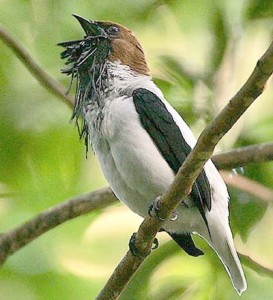Latest update February 22nd, 2025 2:00 PM
Latest News
- $277.9M Mabaruma Magistrates’ Court commissioned at Mabaruma
- Min. Indar scolds contractors over unsanctioned works days after VP Jagdeo called out ministry’s shoddy management of construction sites
- White House expects Ukraine to sign critical minerals deal soon
- Simplify cash grant distribution processes
- Peacemaker chopped after intervening in argument
Interesting Creatures… The Bearded bellbird (Procnias averano)
Jan 25, 2015 Features / Columnists, Interesting Creatures in Guyana
The bearded bellbird (Procnias averano) also known as the campanero or anvil-bird, is a passerine bird which occurs in tropical northern South
America.
There are two subspecies; the nominate taxon, P. a. averano, in northeastern Brazil and P. a. carnobarba in Venezuela, Trinidad, extreme northeastern Colombia, western Guyana and far northern Brazil.
DESCRIPTION AND BEHAVIOUR
This cotinga occurs in humid forests and woodland. It is mainly resident, but some populations take part in altitudinal migrations; breeding at altitudes of up to 1900 m (6250 ft) and spending the non-breeding season in the lowlands. It is a localised and uncommon bird in Venezuela, but is fairly common in Trinidad. The nominate Brazilian race is relatively rare due to extensive habitat destruction in its range and heavy trapping for the cage bird trade, and as such is considered “vulnerable” by Brazilian environmental authority (IBAMA).
Like other cotingas, the bearded bellbird has a broad hooked-tipped bill, rounded wings, strong legs and a striking appearance.
The male is approximately 28 cm 11 in long, and weighs 180 g (6½ oz). His plumage is white or greyish-white apart from the black wings and warm brown head. He sports a grotesque “beard” of un-feathered, black stringy wattles.
The female is smaller, at approximately 27 cm (10½ in) and 130 g (4½ oz). Her upperparts are olive-green (duskier on the head), most of the under parts are yellow streaked with green, and the vent is pure yellow. She lacks the facial wattles (“beard”). Both sexes have dark eyes, a black bill and grey to black legs.
These arboreal bellbirds feed entirely on fruit and berries, mainly taken on the wing. Lauraceae and Burseraceae are particularly favoured, and the young are fed regurgitated Lauraceae by the female.
The males’ advertising calls are a very loud dull Bock repeated every few seconds and a somewhat less loud, metallic hammering tonk-tonk-tonk-tonk. It sounds like a hammer rapidly hitting an anvil and is repeated 20-30 times. Additionally, a number of regional calls are known, e.g. an unmusical, almost hissing, bisset in southern Venezuela and a disyllabic teek-terong in northern Venezuela. Apparently, the last mentioned call is no longer heard in Trinidad. The female is essentially silent.
NESTING
The flimsy nest of twigs is built by the female and usually placed in the outer branches of a tree. The nests are not located in the jungle, but in free-standing trees in semi-cleared areas, probably to reduce the risk from the many effective predators of nests in the jungle such as monkeys, toucans and snakes.
The single brown-mottled, light tan egg is incubated entirely by the female, leaving the polygamous male free to spend much of his time advertising with his distinctive songs. Laying season varies over its range; April-November in Trinidad and May-September in North Venezuela. The first recorded egg was discovered near Cumaca, Trinidad, in the mid-1950s. (Source: Wikipedia – The Free Online Encyclopedia)
Share this:
- Click to print (Opens in new window)
- Click to email a link to a friend (Opens in new window)
- Click to share on Facebook (Opens in new window)
- Click to share on WhatsApp (Opens in new window)
- Click to share on Twitter (Opens in new window)
- Click to share on Pinterest (Opens in new window)
- Click to share on Pocket (Opens in new window)
- Click to share on Tumblr (Opens in new window)
- Click to share on Reddit (Opens in new window)
- Click to share on LinkedIn (Opens in new window)
Related
Similar Articles

The Glenn Lall Show|| February, 14th, 2025
Follow on Tik Tok @Glennlall
THE BLUNT OF THE DAY

Sports
Feb 22, 2025
Kaieteur Sports- Slingerz FC made a bold statement at the just-concluded Guyana Energy Conference and Supply Chain Expo, held at the Marriott Hotel, by blending the worlds of professional football...Features/Columnists
The clock and the cloud
Peeping Tom… Kaieteur News- Time, as the ancients knew, is a trickster. It slips through the fingers of kings and commoners... more
CARICOM Nations Should Respond Together To new U.S. Policies
By Sir Ronald Sanders Ambassador to the US and the OAS, Sir Ronald Sanders Kaieteur News-Two Executive Orders issued by U.S.... more
Publisher’s Note
Freedom of speech is our core value at Kaieteur News. If the letter/e-mail you sent was not published, and you believe that its contents were not libellous, let us know, please contact us by phone or email.
Feel free to send us your comments and/or criticisms.
Contact: 624-6456; 225-8452; 225-8458; 225-8463; 225-8465; 225-8473 or 225-8491.
Or by Email: [email protected] / [email protected]
Weekend Cartoon















